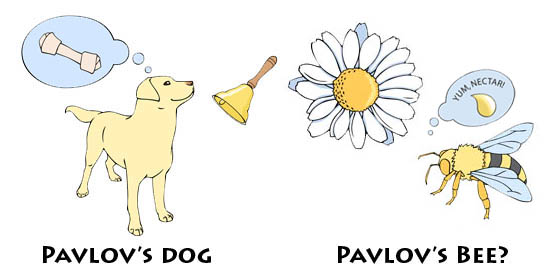
Illustrated by: Sabine Deviche
Okay, so he's not your typical movie director. He doesn't work with the usual actors. The locations of his films are, well, a bit dull. The fact is his work is not likely to come to a theater in your neighborhood anytime in the future. In spite of these shortcomings there is a buzz about his work.
For more than twenty years, making bee movies has been a part of the research work of professor Brian Smith. Capturing the actions of his actors that can beat their wings 200 times a second has required not only a movie camera, but also cameras that can capture the high speed communication skills of his bee actors.
How fast is 200 times a second?
Well, think about it this way, you can blink your eyes about 5 times a second. That makes the beating wings of a honeybee 40 times faster than a blink of an eye.

Keep in mind that bees do a lot of communicating by touch and the sense of vibration. They have to be able to do this since the inside of their beehive is very dark and full of lots and lots of bees. Navigating the inside of this small city takes some pretty amazing sensory skills.
It’s these bee sensory skills that professor Smith is interested in learning about. In particular, he wants to understand how bees use their sense of smell and sight to navigate in their environment. He also spends time communicating with bees directly. Since bees and humans do not have a common language, he spends his time experimenting with different ways that he can train bees. By training them, he learns how bees learn and in a way he is also able to talk to bees.
One of the experiments involves the use of video films of bees that are trained to either respond, or not respond to a cue such as a scent of a flower. The experiment works much the same way that Russian scientist Petrovich Pavlov trained dogs to salivate when he rang a bell. In the case of professor Smith, he has designed experiments with bees. In his experiments the bees do not respond to a bell, but instead to the aroma of a favorite flower.

Filming the bees is very important since bees can move very quickly, including flicking their tongue-like organ, the proboscis, in and out of a flower to lick up sweet nectar. The movements that might be missed by the human eye are caught by the camera. Later, the film can be played back in slow a motion if needed to see how the bees behaved. It’s a good thing that cameras can capture really fast movements, a process called high-speed cinematography. Without these movies professor Smith might not bee able to see what all the buzz is about between bees.
Interest in bees is likely to grow with the release of the movie by Jerry Seinfeld and DreamWorks Studio. The animated cartoon features many lovable bee characters, including one Barry B. Benson played by Jerry Seinfeld.
From the trailers and the interviews about the movie, it looks to be a fun event for the entire family. However, like many movies from Hollywood, some of the details are changed to make for a better story. Unfortunately a lot of the honeybee biology is incorrect in Bee Movie.
Bee Movie
Luckily Dr. Biology, the host of the Ask-a-Biologist podcast program, was in the process of interviewing professor Smith about his research and bee movie making when the Bee Movie was being advertised. He asked professor Smith to talk about honeybee biology to help clear up a few details.
We wanted to bee sure you get the facts about these amazing animals, including their dancing skills and a rather interesting way of sharing food - some call it bee vomit.
Read more about: Bee Movie Maker
Bibliographic details:
- Article: Bee Movie Maker
- Author(s): CJ Kazilek
- Publisher: Arizona State University School of Life Sciences Ask A Biologist
- Site name: ASU - Ask A Biologist
- Date published: 23 Sep, 2009
- Date accessed:
- Link: https://askabiologist.asu.edu/explore/bee_movie_maker
APA Style
CJ Kazilek. (Wed, 09/23/2009 - 14:12). Bee Movie Maker. ASU - Ask A Biologist. Retrieved from https://askabiologist.asu.edu/explore/bee_movie_maker
Chicago Manual of Style
CJ Kazilek. "Bee Movie Maker". ASU - Ask A Biologist. 23 Sep 2009. https://askabiologist.asu.edu/explore/bee_movie_maker
CJ Kazilek. "Bee Movie Maker". ASU - Ask A Biologist. 23 Sep 2009. ASU - Ask A Biologist, Web. https://askabiologist.asu.edu/explore/bee_movie_maker
MLA 2017 Style

Brian Smith with a few thousand of his close bee friends.
Be Part of
Ask A Biologist
By volunteering, or simply sending us feedback on the site. Scientists, teachers, writers, illustrators, and translators are all important to the program. If you are interested in helping with the website we have a Volunteers page to get the process started.

